Comparative Study of Rapid Assessment Methods for Earthquake-Triggered Landslides Based on the Newmark Model—A Case Study of the 2022 Luding Ms6.8 Earthquake
Abstract
:1. Introduction
2. Methods and Data
2.1. Two Assessment Methods Based on the Newmark Model
2.2. Data Source
3. Results
3.1. The Susceptibility of Earthquake-Triggered Landslides in the Research Area
3.2. Assessment Results of the Difference Method
3.3. Assessment Results of the Cumulative Displacement Method
4. Analysis and Discussion
4.1. Analysis of the Assessment Results
4.2. Discussion
5. Conclusions
Author Contributions
Funding
Institutional Review Board Statement
Informed Consent Statement
Data Availability Statement
Conflicts of Interest
References
- Yin, Y.P.; Wang, F.W.; Sun, P. Landslide hazards triggered by the 2008 Wenchuan earthquake, Sichuan, China. Landslides 2009, 6, 139–152. [Google Scholar] [CrossRef]
- Keefer, D.K.; Larsen, M.C. Assessing landslide hazards. Science 2007, 316, 1136–1138. [Google Scholar] [CrossRef] [PubMed]
- Cui, P.; Chen, X.Q.; Zhu, Y.Y.; Su, F.H.; Wei, F.Q.; Han, Y.S.; Liu, H.J.; Zhuang, J.Q. The wenchuan earthquake (may 12, 2008), sichuan province, china, and resulting geohazards. Nat. Hazards 2011, 56, 19–36. [Google Scholar] [CrossRef]
- Xu, C.; Xu, X.; Yao, X.; Dai, F. Three (nearly) complete inventories of landslides triggered by the May 12, 2008 Wenchuan Mw 7.9 earthquake of China and their spatial distribution statistical analysis. Landslides 2014, 11, 441–461. [Google Scholar] [CrossRef]
- Boudriki, B.B.; Molina, C.; Park, H.; Camps, A. First results on the systematic search of land surface temperature anomalies as earthquakes precursors. Remote Sens. 2023, 15, 1110. [Google Scholar] [CrossRef]
- Li, H.Y.; Chen, T.; Yang, F.P.; Chen, Q.; Xu, X.; Zhang, M.; Dai, C.; Zhou, H. Rapid estimation of road landslides based on Newmark method for the 6.1 magnitude earthquake in Lushan, Sichuan. North China Earthq. Sci. 2023, 41, 16–21. (In Chinese) [Google Scholar]
- Nowicki, M.A.; Hamburger, M.W.; Allstadt, K.; Wald, D.J.; Robeson, S.M.; Tanyas, H.; Hearne, M.; Thompson, E.M. A global empirical model for near-real-time assessment of seismically induced landslides. J. Geophys. Res. Earth Surf. 2018, 123, 1835–1859. [Google Scholar] [CrossRef]
- Xu, C.; Xu, X.W.; Dai, F.C.; Wu, Z.; He, H.; Shi, F.; Wu, X.; Xu, S. Application of an incomplete landslide inventory, logistic regression model and its validation for landslide susceptibility mapping related to the may 12, 2008 wenchuan earthquake of china. Nat. Hazards 2013, 68, 883–900. [Google Scholar] [CrossRef]
- Ayalew, L.; Yamagishi, H. The application of GIS-based logistic regression for landslide susceptibility mapping in the Kakuda-Yahiko Mountains, central Japan. Geomorphology 2005, 65, 31. [Google Scholar] [CrossRef]
- Xu, C.; Dai, F.C.; Xu, X.W.; Lee, Y.H. Gis-based support vector machine modeling of earthquake-triggered landslide susceptibility in the Jianjiang river watershed, China. Geomorphology 2012, 145–146, 70–80. [Google Scholar] [CrossRef]
- Yao, X.; Tham, L.G.; Dai, F.C. Landslide susceptibility mapping based on support vector machine: A case study on natural slopes of hong kong, china. Geomorphology 2008, 101, 572–582. [Google Scholar] [CrossRef]
- Pradhan, B.; Lee, S. Landslide susceptibility assessment and factor effect analysis: Backpropagation artificial neural networks and their comparison with frequency ratio and bivariate logistic regression modelling. Environ. Model. Softw. 2010, 25, 747–759. [Google Scholar] [CrossRef]
- Yilmaz, I. (2010). Comparison of landslide susceptibility mapping methodologies for koyulhisar, Turkey: Conditional probability, logistic regression, artificial neural networks, and support vector machine. Environ. Earth Sci. 2010, 61, 821–836. [Google Scholar] [CrossRef]
- Newmark, N.M. Effects of earthquakes on dams and embankments. Géotechnique 1965, 15, 139–160. [Google Scholar] [CrossRef]
- Godt, J.; Sener, B.; Verdin, K.; Wald, D.J.; Earle, P.S.; Harp, E.L.; Jibson, R. Rapid assessment of earthquake-induced landsliding. In Proceedings of the First World Landslide Forum; United Nations University: Tokyo, Japan, 2008. [Google Scholar]
- Zhou, H.J.; Wang, X.; Yuan, Y. Risk assessment of disaster chain: Experience from Wenchuan earthquake-induced landslides in China. J. Mt. Sci. 2015, 12, 1169–1180. [Google Scholar] [CrossRef]
- Wang, T.; Wu, S.R.; Shi, J.S.; Xin, P. Application and validation of seismic landslide displacement analysis based on Newmark model: A case study in Wenchuan earthquake. Acta Geol. Sin. (Engl. Ed.) 2013, 87, 393–397. [Google Scholar]
- Ma, S.Y.; Xu, C. Applicability of two Newmark models in the assessment of coseismic landslide hazard and estimation of slope-failure probability: An example of the 2008 Wenchuan Mw 7.9 earthquake affected area. J. Earth Sci. 2019, 30, 1020–1030. [Google Scholar] [CrossRef]
- Chen, X.L.; Yuan, R.M.; Yu, L. Applying the Newmark’s model to the assessment of earthquake-triggered landslides during the Lushan earthquake. Seismol. Geol. 2013, 35, 661–670. (In Chinese) [Google Scholar]
- Chen, X.L.; Liu, C.G. Assessment of landslides triggered by earthquakes based on the combination of peak ground motion and critical acceleration analysis. In IAEG/AEG Annual Meeting; Springer: San Francisco, CA, USA; Cham, Switzerland, 2019; pp. 123–129. [Google Scholar]
- Chen, X.L.; Liu, C.G.; Wang, M.M.; Zhou, Q. Causes of unusual distribution of coseismic landslides triggered by the Mw 6.1 2014 ludian, yunnan, china earthquake. J. Asian Earth Sci. 2018, 159, 17–23. [Google Scholar] [CrossRef]
- Gallen, S.F.; Clark, M.K.; Godt, J.W.; Roback, K.; Niemi, N.A. Application and evaluation of a rapid response earthquake-triggered landslide model to the 25 April 2015 Mw 7.8 Gorkha earthquake, Nepal. Tectonophysics 2017, 714–715, 173–187. [Google Scholar] [CrossRef]
- Haneberg, W.C.; Johnson, S.E.; Gurung, N. Response of the Laprak, Nepal, landslide to the 2015 Mw 7.8 Gorkha earthquake. Nat. Hazards 2022, 111, 567–584. [Google Scholar] [CrossRef]
- Yue, X.L.; Wu, S.H.; Yin, Y.H.; Gao, J.; Zheng, J. Risk identification of seismic landslides by joint Newmark and rockfall analyst models: A case study of roads affected by the jiuzhaigou earthquake. Int. J. Disaster Risk Sci. 2018, 9, 116–130. [Google Scholar] [CrossRef]
- Chen, X.L.; Shan, X.J.; Zhang, L.; Liu, C.; Han, N.; Lan, J. Quick assessment of earthquake-triggered landslide hazards: A case study of the 2017 Ms7.0 Jiuzhaigou earthquake. Earth Sci. Front. 2019, 26, 312–320. (In Chinese) [Google Scholar]
- Wei, Y.K.; Chen, X.L. Applicability of different seismic landslide risk assessment methods: A case study of Maduo Ms7.4 earthquake. Seismol. Geol. 2022, 44, 590–603. (In Chinese) [Google Scholar]
- Zhang, Y.S.; Yang, Z.H.; Guo, C.B.; Wang, T.; Wang, D.H.; Du, G.L. Predicting landslide scenes under potential earthquake scenarios in the Xianshuihe fault zone, Southwest China. J. Mt. Sci. 2017, 14, 1262–1278. [Google Scholar] [CrossRef]
- Wilson, R.C.; Keefer, D.K. Dynamic analysis of a slope failure from the 6 August 1979 Coyote Lake, California, earthquake. Bull. Seismol. Soc. Am. 1983, 73, 863–877. [Google Scholar] [CrossRef]
- Jibson, R.W. Regression models for estimating coseismic landslide displacement. Eng. Geol. 2007, 91, 209–218. [Google Scholar] [CrossRef]
- Wang, X.; Nie, G.; Ma, M. Evaluation model of landslide hazards induced by the 2008 Wenchuan earthquake using strong motion data. Earthq. Sci. 2011, 24, 311–319. [Google Scholar] [CrossRef]
- Zeng, Y.; Zhang, Y.; Liu, J.; Wang, Q.; Zhu, H. Rapid emergency response assessment of earthquake-induced landslides driven by fusion of InSAR deformation data and Newmark physical models. Remote Sens. 2023, 15, 4605. [Google Scholar] [CrossRef]
- Chen, X.L.; Liu, C.G.; Yu, L.; Lin, C.-X. Critical acceleration as a criterion in seismic landslide susceptibility assessment. Geomorphology 2014, 217, 15–22. [Google Scholar] [CrossRef]
- Maharjan, S.; Gnyawali, K.R.; Tannant, D.D.; Xu, C.; Lacroix, P. Rapid terrain assessment for earthquake-triggered landslide susceptibility with high-resolution DEM and critical acceleration. Front. Earth Sci. 2021, 9, 689303. [Google Scholar] [CrossRef]
- Ambraseys, N.N.; Menu, J.M. Earthquake-induced ground displacements. Earthq. Eng. Struct. Dyn. 1988, 16, 985–1006. [Google Scholar] [CrossRef]
- Jibson, R.W.; Harp, E.L.; Michael, J.A. A Method for Producing Digital Probabilistic Seismic Landslide Hazard Maps: An Example from the Los Angeles, California, Area; U.S. Geological Survey Open-File Report: Washington, DC, USA, 1998; pp. 98–113. [Google Scholar]
- Xu, G.X.; Yao, L.K.; Li, C.H.; Wang, X.F. Predictive models for permanent displacement of slopes based on recorded strong-motion data of Wenchuan earthquake. Chin. J. Geotech. Eng. 2012, 34, 1131–1136. (In Chinese) [Google Scholar]
- Liu, X.M.; Su, P.C.; Li, Y.; Xia, Z.; Ma, S.; Xu, R.; Lu, Y.; Li, D.; Lu, H.; Yuan, R. Spatial distribution of landslide shape induced by Luding Ms6.8 earthquake, Sichuan, China: Case study of the Moxi Town. Landslides 2023, 20, 1667–1678. [Google Scholar] [CrossRef]
- Xiao, Z.K.; Xu, C.; Huang, Y.D.; He, X.; Shao, X.; Chen, Z.; Xie, C.; Li, T.; Xu, X. Analysis of spatial distribution of landslides triggered by the Ms 6.8 Luding earthquake in China on September 5, 2022. Geoenviron. Disasters 2023, 10, 3. [Google Scholar] [CrossRef]
- Zhang, J.J.; Chen, L.; Li, Y.L.; Liu, M.S.; Shi, S.W.; Yi, J.S.; Zhang, W.; Zhang, S.L.; Sun, J.H.; Yang, D.; et al. Development characteristics and controlling factors of coseismic geohazards triggered by the Luding Ms 6.8 earthquake occurred on September 5. 2022. Acta Seismol. Sin. 2023, 45, 167–178. (In Chinese) [Google Scholar]
- Zhang, J.Q.; Yang, Z.J.; Meng, Q.K.; Wang, J.; Hu, K.-H.; Ge, Y.-G.; Su, F.-H.; Zhao, B.; Zhang, B.; Jiang, N.; et al. Distribution patterns of landslides triggered by the 2022 Ms 6.8 Luding earthquake, Sichuan, China. J. Mt. Sci. 2023, 20, 607–623. [Google Scholar] [CrossRef]
- Jibson, R.W.; Harp, E.L.; Michael, J.A. A method for producing digital probabilistic seismic landslide hazard maps. Eng. Geol. 2000, 58, 271–289. [Google Scholar] [CrossRef]
- Hsieh, S.; Lee, C. Empirical estimation of the Newmark displacement from the Arias intensity and critical acceleration. Eng. Geol. 2011, 122, 34–42. [Google Scholar] [CrossRef]
- Dreyfus, D.K.; Rathje, E.M.; Jibson, R.W. The influence of different simplified sliding-block models and input parameters on regional predictions of seismic landslides triggered by the Northridge earthquake. Eng. Geol. 2013, 163, 41–54. [Google Scholar] [CrossRef]
- GB/T 50218-2014; Ministry of Housing and Urban-Rural Development of the People’s Republic of China. Standard for Engineering Classification of Rock Mass. China Planning Press: Beijing, China, 2015. (In Chinese)
- GB/T 17742-2020; State Administration for Market Regulation. The Chinese Seismic Intensity Scale. Standards Press of China: Beijing, China, 2020. (In Chinese)
- Wieczorek, G.F.; Wilson, R.C.; Harp, E.L. Map Showing Slope Stability during Earthquakes in San Mateo County, California; U.S. Geological Survey Miscellaneous Investigations Series Map: Reston, VA, USA, 1985; I,1257E. [Google Scholar]
- Pareek, N.; Pal, S.; Kaynia, A.M.; Sharma, M.L. Empiricalbased seismically induced slope displacements in a geographic information system environment: A case study. Georisk Assess. Manag. Risk Eng. Syst. Geohazards 2014, 8, 258–268. [Google Scholar] [CrossRef]
- Chen, X.L.; Shan, X.J.; Wang, M.M.; Liu, C.-G.; Han, N.-N. Distribution pattern of coseismic landslides triggered by the 2017 Jiuzhaigou Ms7.0 earthquake of China: Control of seismic landslide susceptibility. ISPRS Int. J. Geo-Inf. 2020, 9, 198. [Google Scholar] [CrossRef]
- Chen, X.; Liu, C.; Wang, M. A method for quick assessment of earthquake-triggered landslide hazards: A case study of the Mw6.1 2014 Ludian, China earthquake. Bull. Eng. Geol. Environ. 2018, 78, 2449–2458. [Google Scholar] [CrossRef]
- Swets, J.A. Measuring the accuracy of diagnostic systems. Science 1988, 240, 1285–1293. [Google Scholar] [CrossRef]
- Brenning, A. Spatial prediction models for landslide hazards; review, comparison and evaluation. Nat. Hazards Earth Syst. Sci. 2005, 5, 853–862. [Google Scholar] [CrossRef]
- Roberto, R. Seismically induced landslide displacements: A predictive model. Eng. Geol. 2000, 58, 337–351. [Google Scholar]
- Bojadjieva, J.; Sheshov, V.; Christophe, B. Hazard and risk assessment of earthquake-induced landslides—Case study. Landslides 2018, 15, 161–171. [Google Scholar] [CrossRef]
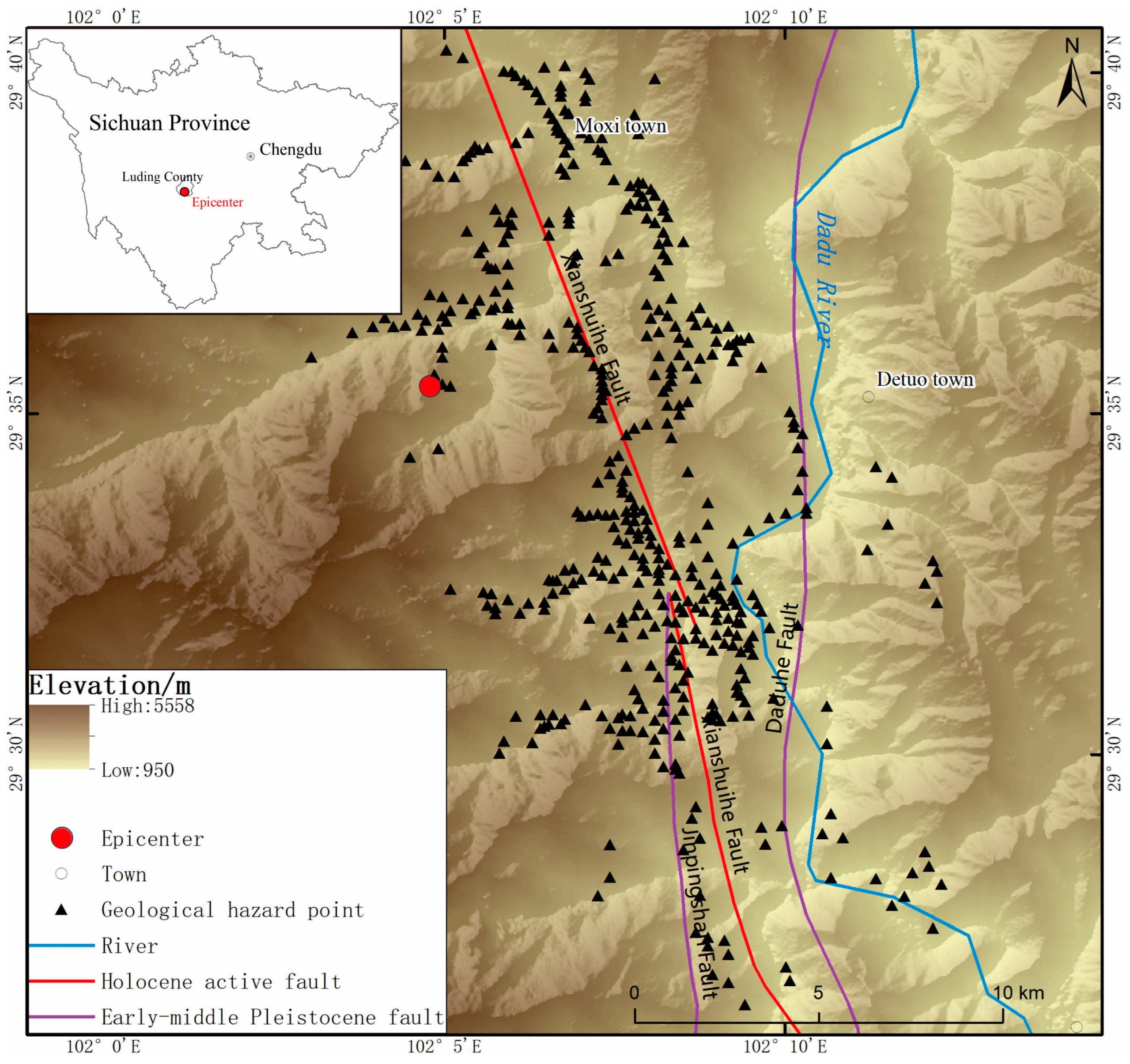


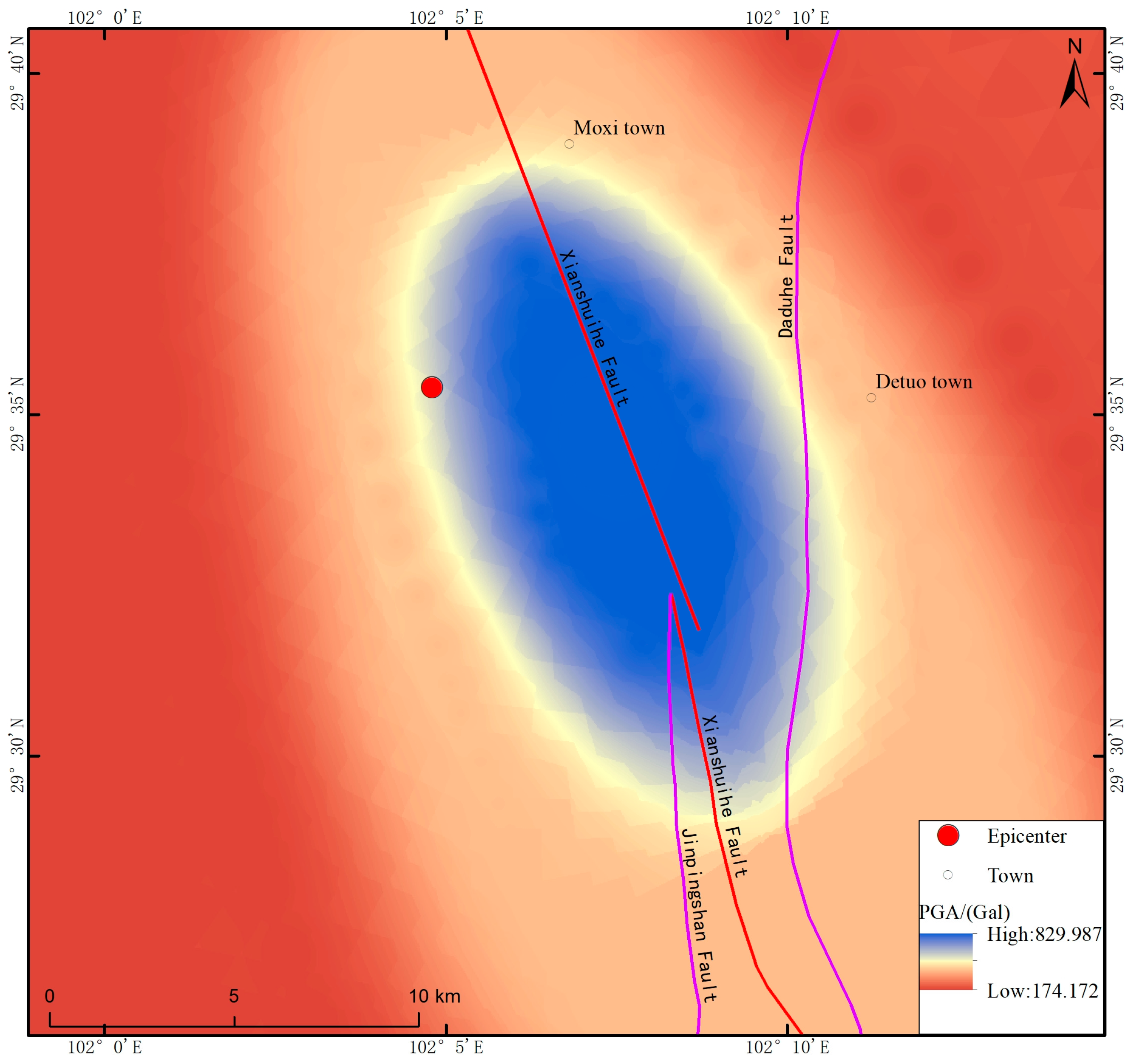

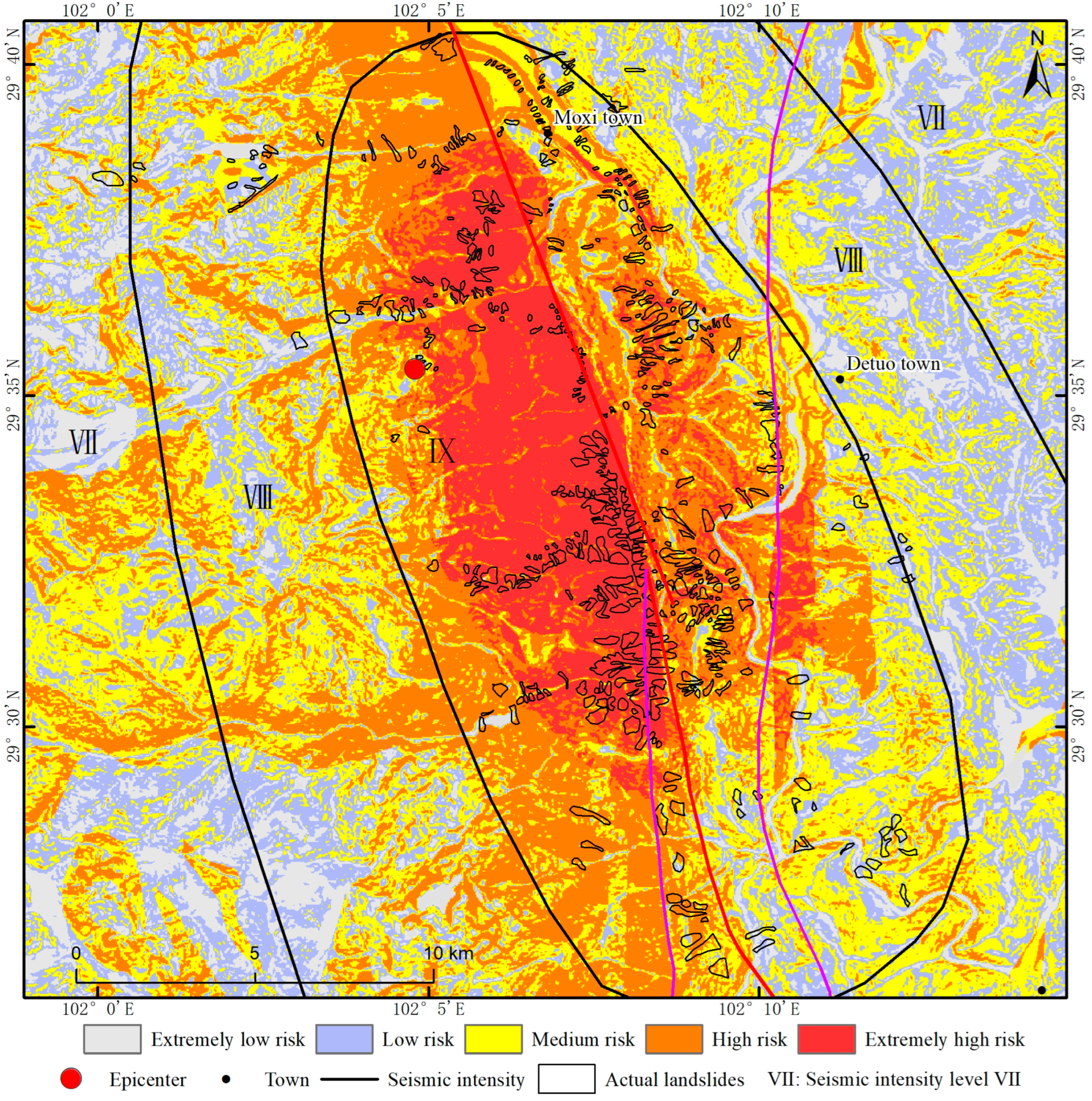


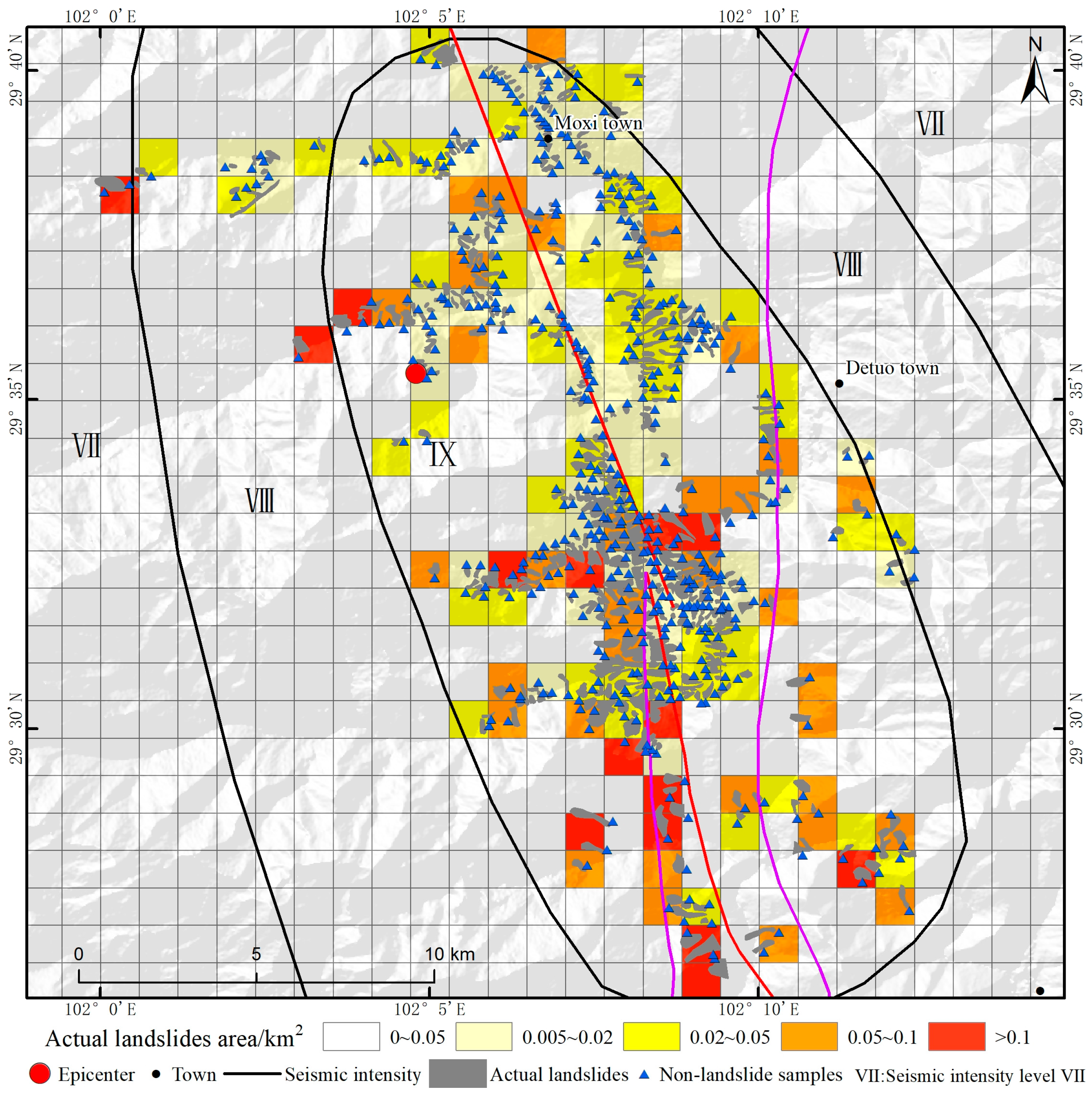
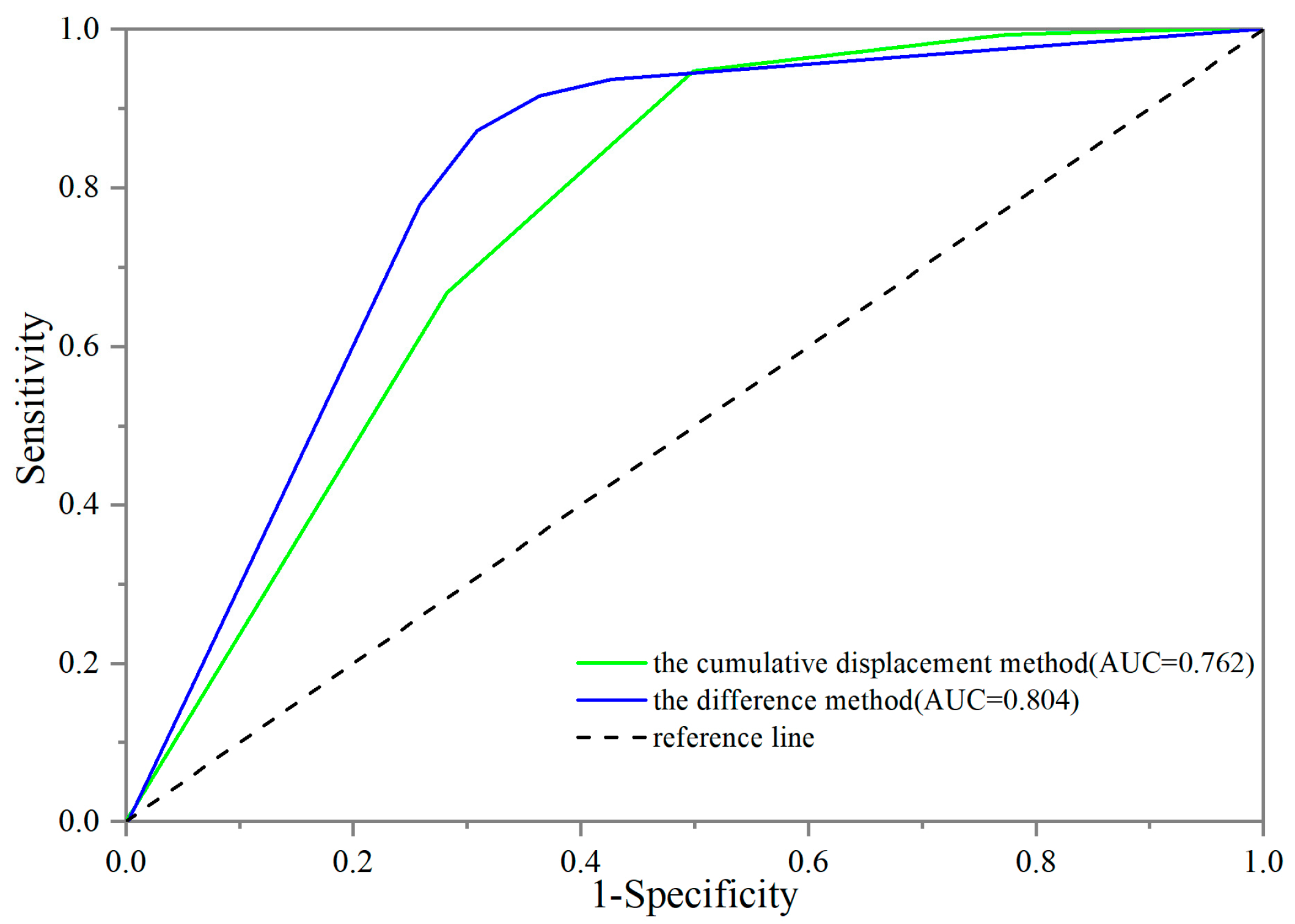
| Rock–Soil Mass | c’ (kPa) | φ’ (°) | γ (kN/m3) |
|---|---|---|---|
| I | 35 | 38 | 26 |
| II | 28 | 33 | 23 |
| III | 22 | 24 | 22 |
| IV | 15 | 10 | 16 |
Disclaimer/Publisher’s Note: The statements, opinions and data contained in all publications are solely those of the individual author(s) and contributor(s) and not of MDPI and/or the editor(s). MDPI and/or the editor(s) disclaim responsibility for any injury to people or property resulting from any ideas, methods, instructions or products referred to in the content. |
© 2024 by the authors. Licensee MDPI, Basel, Switzerland. This article is an open access article distributed under the terms and conditions of the Creative Commons Attribution (CC BY) license (https://creativecommons.org/licenses/by/4.0/).
Share and Cite
Li, H.; Li, D.; Yin, J.; Sun, H.; Li, M.; Dai, C. Comparative Study of Rapid Assessment Methods for Earthquake-Triggered Landslides Based on the Newmark Model—A Case Study of the 2022 Luding Ms6.8 Earthquake. Appl. Sci. 2024, 14, 7500. https://doi.org/10.3390/app14177500
Li H, Li D, Yin J, Sun H, Li M, Dai C. Comparative Study of Rapid Assessment Methods for Earthquake-Triggered Landslides Based on the Newmark Model—A Case Study of the 2022 Luding Ms6.8 Earthquake. Applied Sciences. 2024; 14(17):7500. https://doi.org/10.3390/app14177500
Chicago/Turabian StyleLi, Huanyu, Dongping Li, Jingfei Yin, Haiqing Sun, Min Li, and Chenbing Dai. 2024. "Comparative Study of Rapid Assessment Methods for Earthquake-Triggered Landslides Based on the Newmark Model—A Case Study of the 2022 Luding Ms6.8 Earthquake" Applied Sciences 14, no. 17: 7500. https://doi.org/10.3390/app14177500







